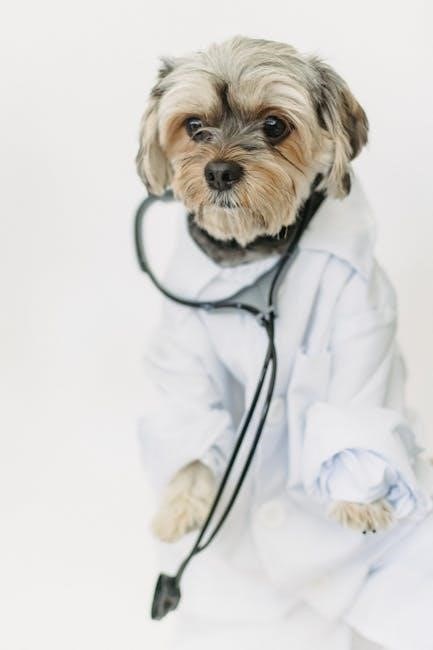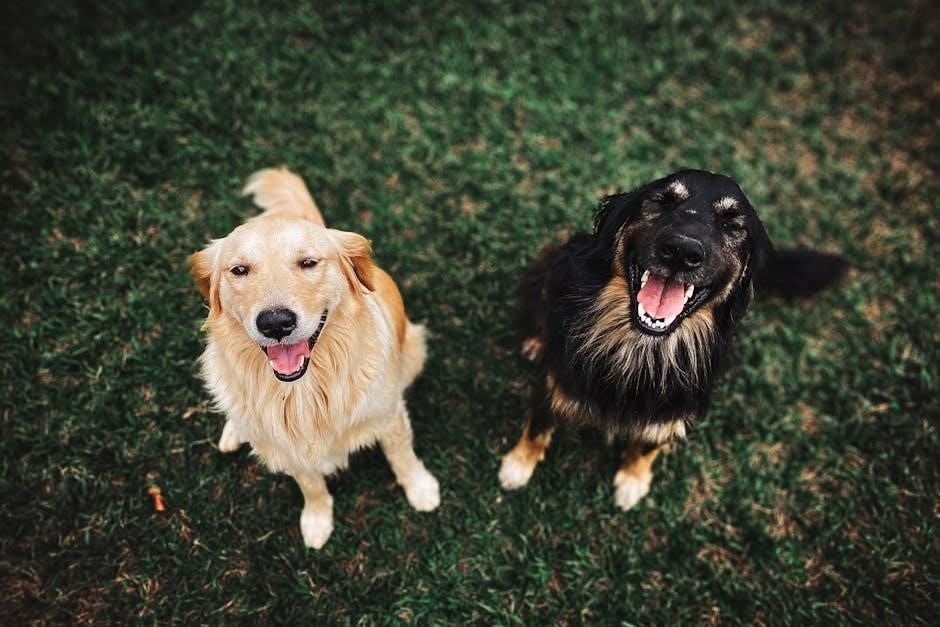Many common human foods can be harmful to dogs, posing serious health risks. Understanding which foods are toxic is crucial for pet owners to ensure their dog’s safety.
Understanding the Risks of Human Foods for Canines
Human foods, while harmless to people, can pose significant risks to dogs due to their unique physiology. Certain ingredients, like chocolate, grapes, and onions, contain compounds toxic to canines, leading to severe health issues. Even small amounts can trigger reactions, ranging from mild discomfort to life-threatening conditions. Pet owners often unknowingly expose their dogs to these dangers, emphasizing the need for awareness. Understanding which foods are safe and which are harmful is essential to prevent accidental poisoning and ensure a dog’s well-being. This knowledge helps pet owners make informed decisions about their dog’s diet and environment.
Common Toxic Foods for Dogs
Chocolate, grapes, onions, and macadamia nuts are among the most dangerous foods for dogs. Awareness of these risks is crucial for protecting your pet’s health and safety.
Chocolate and Its Effects on Canine Health
Chocolate contains theobromine, a compound toxic to dogs. Dark chocolate and baking chocolate are the most dangerous due to higher theobromine levels. Ingestion can cause vomiting, diarrhea, increased heart rate, and seizures. In severe cases, it can lead to heart failure or death. The severity of symptoms depends on the type and amount of chocolate consumed. Even small amounts can harm smaller breeds. If your dog ingests chocolate, contact a veterinarian immediately for treatment. Awareness of this common household hazard is essential for protecting your dog’s health and preventing potentially fatal outcomes.
Grapes and Raisins: Hidden Dangers in Small Portions
Grapes and raisins are highly toxic to dogs, even in small amounts, and can cause severe kidney failure. The exact toxin responsible is unknown, but ingestion can lead to rapid health decline. Symptoms include vomiting, lethargy, and dehydration, with kidney failure developing within 24-48 hours. Immediate veterinary attention is critical if consumption is suspected. Prompt treatment, such as inducing vomiting or administering activated charcoal, can improve outcomes. Preventing access to grapes and raisins is essential to protect your dog from this potentially fatal threat. Always keep these foods out of reach to ensure your pet’s safety and well-being.
Macadamia Nuts: Why They Are Harmful to Dogs
Macadamia nuts are toxic to dogs and can cause weakness, depression, vomiting, tremors, and hyperthermia. The exact toxin is unknown, but even small amounts can trigger symptoms within 3-12 hours. While the effects are typically short-lived, lasting 24-48 hours, severe cases may require veterinary intervention. It’s crucial to keep macadamia nuts out of your dog’s reach to prevent accidental ingestion. If you suspect your dog has eaten them, consult a veterinarian immediately for guidance. Awareness of these risks helps ensure your pet’s safety and well-being.
Avocado: The Pitfalls and Safe Consumption Limits
Avocados can be harmful to dogs due to a toxic compound called persin, found in the pit, skin, and leaves. While the fruit’s flesh is generally safe in small amounts, excessive consumption can lead to gastrointestinal upset. The pit poses a choking hazard and can cause intestinal blockages if swallowed. Dogs with sensitivities may experience vomiting or diarrhea after eating avocado. Moderation is key, and avoiding the pit, skin, and leaves is essential. Always consult a veterinarian if your dog ingests any part of an avocado to ensure their safety and address any potential risks promptly.
Xylitol: The Sugar Substitute Deadly to Dogs
Xylitol, a common sugar substitute in human products like gum, candies, and peanut butter, is highly toxic to dogs. It causes a rapid drop in blood sugar and can lead to liver failure. Even small amounts can trigger severe symptoms, including vomiting, seizures, and lethargy. If ingested, immediate veterinary attention is crucial. Products containing xylitol should be kept out of reach, and pet owners must always check labels. Early treatment can prevent fatal outcomes, making awareness and prevention essential for safeguarding dogs from this deadly substance.
Caffeine: Its Impact on Canine Nervous Systems
Caffeine, found in coffee, tea, and energy drinks, is highly toxic to dogs. It affects their nervous system, causing hyperactivity, restlessness, and rapid heart rates. In severe cases, it can lead to seizures, heart failure, or even death. Dogs metabolize caffeine slowly, prolonging its effects. Common sources include discarded coffee grounds or tea bags. Pet owners should store caffeinated products securely and monitor their dogs closely. If ingestion occurs, immediate veterinary care is essential to prevent life-threatening complications. Awareness of caffeine’s dangers is crucial for protecting dogs from accidental poisoning.
Alcohol: The Risks of Ethanol for Dogs
Ethanol, the active ingredient in alcohol, is highly toxic to dogs. Even small amounts can cause severe health issues, including vomiting, diarrhea, and difficulty breathing. Dogs metabolize alcohol differently than humans, leading to rapid absorption and intensified effects. Symptoms can progress to tremors, seizures, and coma, potentially resulting in death. Common sources of ethanol include alcoholic beverages, raw dough, and certain medications. Pet owners must store alcohol securely and avoid sharing any products containing ethanol with their dogs. Immediate veterinary attention is critical if ingestion occurs, as prompt treatment can prevent fatal outcomes.
Raw or Undercooked Meat, Eggs, and Fish
Raw or undercooked meat, eggs, and fish pose significant health risks to dogs due to the presence of harmful bacteria like Salmonella and E. coli. These pathogens can cause severe gastrointestinal distress, including vomiting, diarrhea, and abdominal pain. Additionally, raw fish may contain thiaminase, an enzyme that breaks down thiamine (vitamin B1), leading to deficiency over time. Symptoms can progress to neurological issues if left untreated. It’s crucial to avoid feeding dogs raw or undercooked products and opt for thoroughly cooked alternatives to ensure their safety and prevent bacterial infections. Always consult a veterinarian for dietary advice tailored to your dog’s needs.
Dairy Products and Lactose Intolerance in Dogs
Dairy products can be problematic for dogs due to lactose intolerance, as many dogs lack the enzyme lactase needed to digest lactose. Consuming milk, cheese, or other dairy items can lead to digestive issues like diarrhea, bloating, and gas; While some dogs may tolerate small amounts of plain, unflavored yogurt with live cultures, excessive dairy consumption can cause discomfort. It’s important to avoid feeding dogs dairy regularly and opt for lactose-free or non-dairy alternatives if necessary. Always monitor your dog’s reaction to new foods and consult a veterinarian for personalized dietary advice.
Salt and Sodium Toxicity in Canines
Salt and sodium can be toxic to dogs, causing electrolyte imbalances that lead to severe health issues. Consuming large amounts, such as from salty snacks or soy sauce, can result in vomiting, diarrhea, seizures, and even organ failure. Dogs are highly sensitive to sodium overload, which can disrupt nerve and muscle function. Preventing toxicity involves keeping salty foods out of reach and avoiding seasoning their meals. Always opt for dog-safe alternatives and consult a veterinarian if you suspect sodium poisoning, as prompt treatment is essential for recovery.
Yeast Dough: The Danger of Rising Dough in Dogs
Yeast dough can be highly toxic to dogs due to its ability to rise in the stomach, causing severe discomfort and potential blockages. As the dough ferments, it produces ethanol, which is toxic to dogs. Ingestion can lead to bloating, vomiting, and even life-threatening complications like gastric rupture. Symptoms may include lethargy, abdominal pain, and difficulty breathing. It’s crucial to keep all raw yeast dough out of reach of dogs and seek immediate veterinary care if ingestion occurs, as timely treatment is essential to prevent serious health issues.
Mushrooms: The Potentially Fatal Fungi for Dogs
Mushrooms can be highly toxic to dogs, with certain species causing severe health issues or even death. Some mushrooms contain toxins that can damage a dog’s liver or kidneys, leading to organ failure. Symptoms of mushroom toxicity may include vomiting, diarrhea, lethargy, and abdominal pain. If a dog ingests any type of mushroom, it is critical to seek immediate veterinary care, as prompt treatment can significantly improve outcomes. Keeping mushrooms out of reach and educating yourself about toxic species are essential steps to protect your dog from this potentially fatal risk.
Why These Foods Are Toxic
These foods contain toxic compounds that can disrupt a dog’s biological systems, leading to severe health issues or organ failure, making them dangerous for consumption.
The Science Behind Food Toxicity in Dogs
Toxic foods for dogs contain specific compounds that interfere with canine biology. For example, chocolate has theobromine, which dogs metabolize slowly, leading to nervous system overload. Grapes and raisins contain unidentified toxins that can cause kidney failure. Onions and garlic disrupt red blood cells, potentially causing anemia. These substances, harmless to humans, are deadly to dogs due to their unique physiology. Understanding these biochemical interactions is key to preventing poisoning and ensuring safe dietary choices for pets.


Symptoms of Food Poisoning in Dogs
Vomiting, diarrhea, lethargy, and loss of appetite are common signs. Severe cases may include seizures, tremors, or difficulty breathing, requiring immediate veterinary attention.
Recognizing the Signs of Toxicity
Recognizing the signs of toxicity in dogs is crucial for timely intervention. Common symptoms include vomiting, diarrhea, lethargy, and loss of appetite. In severe cases, dogs may exhibit seizures, tremors, or difficulty breathing. Other indicators can be excessive drooling, pale gums, or an elevated heart rate. Some toxins may cause immediate reactions, while others might show delayed symptoms. Pet owners should monitor their dogs closely after ingestion of suspicious substances. Early detection of these signs can significantly improve treatment outcomes. If any unusual behavior is observed, seeking veterinary care promptly is essential to prevent potentially life-threatening complications.

Preventing Food Poisoning in Dogs
Preventing food poisoning in dogs involves securing toxic substances, using safe treats, and educating owners on harmful foods to ensure their pets’ well-being and safety.

Safe Food Alternatives for Dogs
Providing safe, healthy alternatives is key to preventing food poisoning in dogs. Carrots, green beans, and apples are excellent choices, offering nutritional benefits without risks. Cooked chicken, plain rice, and oatmeal are also safe options. Always avoid seasonings and opt for plain, unprocessed foods. Consulting a veterinarian can help tailor dietary choices to your dog’s specific needs. By choosing these alternatives, you ensure your dog enjoys treats safely, reducing the risk of toxicity and promoting overall health.

Proper Food Storage and Disposal
Securely storing food and properly disposing of waste are critical to preventing accidental ingestion of toxic substances by dogs. Use airtight containers for potentially harmful foods and keep them out of reach. Dispose of leftovers, especially toxic items like chocolate or grapes, in sealed trash cans. Regularly clean up crumbs and spills to avoid temptation. Labeling toxic foods clearly can also help prevent mistakes. By maintaining a safe and tidy environment, you minimize the risk of your dog accessing dangerous items, ensuring their well-being and safety.
What to Do If Your Dog Ingests Toxic Food
Stay calm and contact your veterinarian immediately. Induce vomiting only if advised. Administer activated charcoal under guidance. Keep emergency vet contact handy always.
Immediate Steps to Take
If your dog ingests toxic food, stay calm and act quickly. Contact your veterinarian or a pet poison hotline immediately for guidance. Do not induce vomiting unless instructed by a professional. Secure the food packaging or substance for identification. Monitor your dog’s symptoms closely and follow any advice provided. Prompt action can prevent severe health complications. Keep emergency contact numbers handy to ensure rapid response. Remember, timely intervention is critical to safeguarding your dog’s health and well-being.
When to Contact a Veterinarian
If your dog shows signs of illness after eating something potentially toxic, contact a veterinarian immediately. Symptoms like vomiting, lethargy, or difficulty breathing require urgent attention. Even if your dog seems fine, some toxins can cause delayed reactions, so professional advice is essential. Do not wait for symptoms to worsen, as early intervention can significantly improve outcomes. Your veterinarian can provide guidance based on the type and amount of food consumed. Prompt consultation ensures the best chance of preventing serious health complications for your dog.

Long-Term Effects of Toxic Food Ingestion
Ingesting toxic foods can lead to severe, long-term health issues in dogs, including organ damage, chronic illnesses, or even life-threatening conditions if not addressed promptly by a veterinarian.
Understanding Potential Health Complications
Ingesting toxic foods can lead to severe health complications in dogs, including organ damage, chronic illnesses, or life-threatening conditions. Prolonged exposure to toxins may result in kidney or liver failure, while certain substances can disrupt the nervous system, leading to seizures or paralysis. Some toxins, like those from grapes or raisins, can cause irreversible kidney damage, even in small amounts. Long-term effects may also include gastrointestinal disorders, respiratory issues, or weakened immune systems. Prompt veterinary care is essential to mitigate these complications and prevent permanent harm. Regular monitoring and early intervention are critical for ensuring a dog’s long-term health and well-being.

Safe Human Foods for Dogs
Healthy alternatives like oatmeal, carrots, and chicken offer nutritional benefits for dogs without the risks. These foods provide essential vitamins and minerals, promoting overall canine well-being safely.
Healthy Alternatives to Toxic Foods
For dog owners, identifying safe human foods is essential. Oatmeal, carrots, and green beans are excellent, non-toxic options that support digestion and overall health. Cooked chicken and plain, unseasoned rice are also safe and nutritious. These alternatives provide essential nutrients without the risks associated with toxic foods. Introducing these in moderation can satisfy your dog’s curiosity and appetite while ensuring their safety. Always consult a veterinarian before making significant changes to your dog’s diet to ensure it remains balanced and meets their nutritional needs.
Consulting a Veterinarian
Consulting a veterinarian is crucial for ensuring your dog’s diet is safe and balanced. They provide professional guidance on avoiding toxic foods and ensuring your dog’s overall health and safety.
The Importance of Professional Advice
Seeking professional advice from a veterinarian is essential for protecting your dog from toxic foods. Veterinarians can provide tailored guidance based on your dog’s specific needs, breed, and health conditions. They can help identify potential risks and offer personalized recommendations to ensure your dog’s diet is safe and balanced. Regular consultations can also address concerns about human foods and prevent accidental ingestion of harmful substances. By leveraging their expertise, you can create a safer environment for your dog and avoid costly health complications. Professional advice is a cornerstone of responsible pet ownership and ensures your dog’s well-being.
Creating a Safe Environment for Dogs

Securing your home from toxic substances is vital. Store harmful foods and items out of reach; Supervise during meals to prevent accidental ingestion. Dog-proof your space to ensure safety.
Securing Your Home from Toxic Substances
Creating a safe environment involves securing toxic substances out of your dog’s reach. Store harmful foods, medications, and cleaning supplies in locked cabinets or high shelves. Supervise during meals to prevent accidental ingestion of dangerous items. Dispose of waste properly, especially food scraps like chocolate, grapes, or onions, which are highly toxic. Use pet-safe cleaning products and keep them inaccessible. Regularly inspect your home for potential hazards, such as loose items or spills, to ensure your dog’s safety. By taking these steps, you can significantly reduce the risk of poisoning and create a secure space for your furry friend.
Community Awareness and Education
Raising awareness about toxic foods for dogs is vital. Educating pet owners through workshops, social media, and local campaigns can prevent accidental poisoning and save lives.
Sharing Knowledge to Protect Pets
Sharing knowledge about toxic foods for dogs is essential for pet safety. By educating others, we can prevent accidental ingestion of harmful substances like chocolate, grapes, and onions. Many pet owners unknowingly offer dangerous treats, highlighting the need for awareness campaigns. Communities can organize workshops, share informative materials, and use social media to spread the word. Collaboration between veterinarians, pet stores, and local groups can amplify these efforts. Educating others not only protects individual pets but also fosters a safer environment for all dogs, reducing the risk of poisoning and promoting healthier, happier lives for our furry friends.

Future Research and Updates
Ongoing studies continue to uncover new insights into toxic foods for dogs, emphasizing the importance of staying informed to protect pets from evolving dietary risks.
Staying Informed About Pet Safety
Staying informed about pet safety is essential for dog owners to protect their pets from potential threats. Regularly updating your knowledge on toxic foods ensures you can identify risks and act quickly. Reliable sources like veterinary guidelines, scientific studies, and pet safety organizations provide the latest information. As research evolves, new foods may be identified as harmful, while others may be deemed safe. Engaging with pet communities and forums can also help spread awareness. By staying informed, you can prevent accidental ingestion and ensure your dog leads a healthy, safe life. Awareness is key to safeguarding your furry friend.
Final Thoughts on Keeping Your Dog Safe
Protecting your dog from toxic foods requires awareness, education, and vigilance. By understanding risks and taking preventive measures, you can ensure a safe and healthy life for your pet.
Protecting your dog from toxic foods is a lifelong commitment. Awareness of harmful ingredients like chocolate, grapes, and onions is key. Always opt for dog-safe alternatives and store toxic substances securely. Educating yourself and others ensures a safer environment for pets. Regular veterinary check-ups and immediate action if toxicity is suspected are vital. By staying informed and vigilant, you can prevent accidents and provide a healthy, happy life for your furry companion. Remember, knowledge is the best tool in safeguarding your dog’s well-being.
